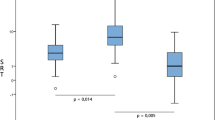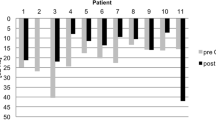Abstract
Sequential bilateral cochlear implantation in children becomes less effective as the inter-implant interval increases. However, the cause of this and the age at which speech perception becomes impossible are unclear. We examined the cases of 11 prelingually deaf children who underwent unilateral cochlear implantation at our hospitals before the age of 5 years old, followed by a second implantation procedure on the contralateral side when they were aged ≥ 6 years old (6–12 years old). The subjects’ hearing thresholds and speech discrimination scores for the second cochlear implant were evaluated at 3 postoperative months and 1–7 years. All of the subjects demonstrated improvements in their hearing thresholds to a mean of 30 dB HL at 1 year. Regarding speech perception, one patient (a 12-year-old), who had developed bilateral hearing loss at 30 months of age after contracting mumps, demonstrated a 90% improvement in his speech discrimination score at 1 year. However, among the other congenitally deaf children, there were two patients whose speech discrimination scores had improved by ≥ 80% at > 4 postoperative years. The congenitally deaf children exhibited poor speech perception despite showing improved hearing thresholds in the ears that received second cochlear implants. Assuming that the auditory pathway beyond the superior olivary complex remained functional, the reduced speech perception abilities associated with the second cochlear implants may have been attributable to the loss of the spiral ganglion and cochlear nucleus cells due to a lack of auditory input since birth.

Similar content being viewed by others
References
Lee DS, Lee JS, Oh SH, Kim SK, Kim JW, Chung JK, Lee MC, Kim CS (2001) Cross-modal plasticity and cochlear implants. Nature 409:149–150
Kral A, Sharma A (2012) Developmental neuroplasticity after cochlear implantation. Trends Neurosci 35:111–122
Basura GJ, Eapen R, Buchman CA (2009) Bilateral cochlear implantation: current concepts, indications, and results. Laryngoscope 119:2395–2401
Sparreboom M, Snik AF, Mylanus EA (2012) Sequential bilateral cochlear implantation in children: quality of life. Arch Otolaryngol Head Neck Surg 38:134–141
Lammers MJ, Venekamp RP, Grolman W, van der Heijden GJ (2014) Bilateral cochlear implantation in children and the impact of the inter-implant interval. Laryngoscope 124:993–999
Illg A, Giourgas A, Kral A, Büchner A, Lesinski-Schiedat A, Lenarz T (2013) Speech comprehension in children and adolescents after sequential bilateral cochlear implantation with long interimplant interval. Otol Neurotol 34:682–689
Okuda T, Nagamachi S, Ushisako Y, Tono T (2013) Glucose metabolism in the primary auditory cortex of postlingually deaf patients: an FDG-PET study. ORL J Otorhinolaryngol Relat Spec 75:342–349
Peters BR, Litovsky R, Parkinson A, Lake J (2007) Importance of age and postimplantation experience on speech perception measures in children with sequential bilateral cochlear implants. Otol Neurotol 28:649–657
Scherf F, van Deun L, van Wieringen A, Wouters J, Desloovere C, Dhooge I, Offeciers E, Deggouj N, De Raeve L, De Bodt M, Van de Heyning PH (2007) Hearing benefits of second-side cochlear implantation in two groups of children. Int J Pediatr Otorhinolaryngol 71:1855–1863
Wolfe J, Baker S, Caraway T, Kasulis H, Mears A, Smith J, Swim L, Wood M (2007) 1-year postactivation results for sequentially implanted bilateral cochlear implant users. Otol Neurotol 28:589–596
Sharma A, Dorman M, Spahr A, Todd NW (2002) Early cochlear implantation in children allows normal development of central auditory pathways. Ann Otol Rhinol Laryngol Suppl 189:38–41
Sharma A1, Dorman MF, Spahr AJ (2002) A sensitive period for the development of the central auditory system in children with cochlear implants: implications for age of implantation. Ear Hear 23:532–539
Starr A, Picton TW, Sininger Y, Hood LJ, Berlin CI (1996) Auditory neuropathy. Brain 119:741–753
Kaga K, Nakamura M, Shinogami M, Tsuzuku T, Yamada K, Shindo M (1996) Auditory nerve disease of both ears revealed by auditory brainstem responses, electrocochleography and otoacoustic emissions. Scand Audiol 25:233–238
Kawano A, Seldon HL, Clark GM, Ramsden RT, Raine CH (1998) Intracochlear factors contributing to psychophysical percepts following cochlear implantation. Acta Otolaryngol 118:313–326
Shiroma M, Honda K, Yamanaka N, Kawano J, Yukawa K, Kumakawa K, Funasaka S (1992) Factors contributing to phoneme recognition ability of users of the 22-channel cochlear implant system. Ann Otol Rhinol Laryngol 101:32–37
Kamakura T, Nadol JB Jr (2016) Correlation between word recognition score and intracochlear new bone and fibrous tissue after cochlear implantation in the human. Hear Res 339:132–141
Hinojosa R, Seligsohn R, Lerner SA (1985) Ganglion cell counts in the cochleae of patients with normal audiograms. Acta Otolaryngol 99:8–13
Tierney TS, Russell FA, Moore DR (1997) Susceptibility of developing cochlear nucleus neurons to deafferentation-induced death abruptly ends just before the onset of hearing. J Comp Neurol 378:295–306
Leake PA, Stakhovskaya O, Hradek GT, Hetherington AM (2008) Factors influencing neurotrophic effects of electrical stimulation in the deafened developing auditory system. Hear Res 242:86–99
Savvas E, Heslinga K, Sundermann B, Schwindt W, Spiekermann CO, Koopmann M, Rudack C (2020) Prognostic factors in cochlear implantation in adults: determining central process integrity. Am J Otolaryngol 41:102435
Kanda Y, Kumagami H, Hara M, Sainoo Y, Sato C, Yamamoto-Fukuda T, Yoshida H, Ito A, Tanaka C, Baba K, Nakata A, Tanaka H, Takahashi H (2012) Bilateral cochlear implantation for children in nagasaki, Japan. Clin Exp Otorhinolaryngol 5:S24-31
Galvin KL, Hughes KC, Mok M (2010) Can adolescents and young adults with prelingual hearing loss benefit from a second, sequential cochlear implant? Int J Audiol 49:368–377
Sparreboom M, Snik AF, Mylanus EA (2011) Sequential bilateral cochlear implantation in children: development of the primary auditory abilities of bilateral stimulation. Audiol Neurotol 16:203–213
Scherf FWAC, van Deun L, van Wieringen A, Wouters J, Desloovere C, Dhooge I, Offeciers F, Deggouj N, Raeve LD, Bodt MD, Van de Heyning PH (2009) Functional outcome of sequential bilateral cochlear implantation in young children: 36 months postoperative results. Int J Pediatr Otorhinolaryngol 73:723–730
Schleich P, Nopp P, D’Haese P (2004) Head shadow, squelch, and summation effects in bilateral users of the MED-EL COMBI 40/40+ cochlear implant. Ear Hear 25:197–204
Acknowledgements
The authors would like to thank the staff of the Department of Otorhinolaryngology of Kagoshima City Hospital for their help.
Author information
Authors and Affiliations
Corresponding author
Ethics declarations
Conflict of Interest
The authors have no conflicts of interest to declare.
Informed Consent
This was a retrospective study; therefore, formal consent was not required.
Additional information
Publisher's Note
Springer Nature remains neutral with regard to jurisdictional claims in published maps and institutional affiliations.
Rights and permissions
Springer Nature or its licensor holds exclusive rights to this article under a publishing agreement with the author(s) or other rightsholder(s); author self-archiving of the accepted manuscript version of this article is solely governed by the terms of such publishing agreement and applicable law.
About this article
Cite this article
Okuda, T., Matsuda, Y., Tsumagari, S. et al. Speech Perception of Second Cochlear Implant after 6 Years of Age in Prelingually Deaf Children. Indian J Otolaryngol Head Neck Surg 75 (Suppl 1), 32–37 (2023). https://doi.org/10.1007/s12070-022-03183-1
Received:
Accepted:
Published:
Issue Date:
DOI: https://doi.org/10.1007/s12070-022-03183-1




